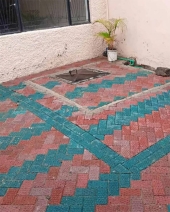
 26
26




![Filename: IMG_20220609_153148_898.jpg
Description: [Thumbnail for IMG_20220609_153148_898.jpg]](/t/182758/a/180366/IMG_20220609_153148_898.jpg)
 8
8




Invasive plants are Earth's way of insisting we notice her medicines. Stephen Herrod Buhner
Everyone learns what works by learning what doesn't work. Stephen Herrod Buhner




“A kind gesture can reach a wound that only compassion can heal”
 6
6




thank you fro the kind words!Briella Ac wrote:This is awesome, never heard of this before! Good work
 6
6




 6
6




Douglas Alpenstock wrote:I like the concept. I have seen a number of companies start up on similar concepts.
One problem they ran into was that the plastic lumber would sag in summer temperatures (e.g., saggy picnic tables). It seems to need more structural support. Have you run into this problem?
Of course that dosn't apply to ground contact applications, where the plastic lumber is evenly supported.
 9
9




Trees are our friends
 3
3




Daniel Schmidt wrote:I came across a similarly designed injection molding machine a few weeks back. I love the idea of recycling being done locally instead of the current situation that has numerous inefficiencies. I figure having more ideas for different methods will help motivate more people in this space.
 3
3




Real funny, Scotty, now beam down my clothes!
 2
2




$10.00 is a donation. $1,000 is an investment, $1,000,000 is a purchase.
 8
8




Cécile Stelzer Johnson wrote:I would like to build a machine that turns plastic waste into small chips. I could then sit at my local transfer station and pick the garbage to chip it. While the extrusion machine is above my ability to build at present, I'd love to resell these chips for such construction. If nothing else, it would save a lot of money for my town by seriously compacting the trash they have to deal with. Are there any better designs out there? How closely should the various plastics be sorted or commingled?
Be the shenanigans
you want to see in the world.

 3
3




 5
5




K Eilander wrote:
Cécile Stelzer Johnson wrote:I would like to build a machine that turns plastic waste into small chips. I could then sit at my local transfer station and pick the garbage to chip it. While the extrusion machine is above my ability to build at present, I'd love to resell these chips for such construction. If nothing else, it would save a lot of money for my town by seriously compacting the trash they have to deal with. Are there any better designs out there? How closely should the various plastics be sorted or commingled?
Most of the shredder designs I've seen use lots of lazer or plasma cut blades, which makes them a little hard for the average person to construct.
 6
6




 11
11




 7
7




Small-holding, coppice and grassland management on a 16-acre site.
 6
6




![Filename: bench.jpg
Description: [Thumbnail for bench.jpg]](/t/182758/a/206331/bench.jpg)
Small-holding, coppice and grassland management on a 16-acre site.
 12
12




 7
7




 5
5




![Filename: 0b19ae2b-5860-4a69-8a2f-b30c8e20223e.jpeg
Description: [Thumbnail for 0b19ae2b-5860-4a69-8a2f-b30c8e20223e.jpeg]](/t/182758/a/260904/0b19ae2b-5860-4a69-8a2f-b30c8e20223e.jpeg)
 12
12





 7
7




How Permies works: https://permies.com/wiki/34193/permies-works-links-threads
My projects on Skye: The tree field, Growing and landracing, perennial polycultures, "Don't dream it - be it! "
 6
6





| I agree. Here's the link: http://stoves2.com |







